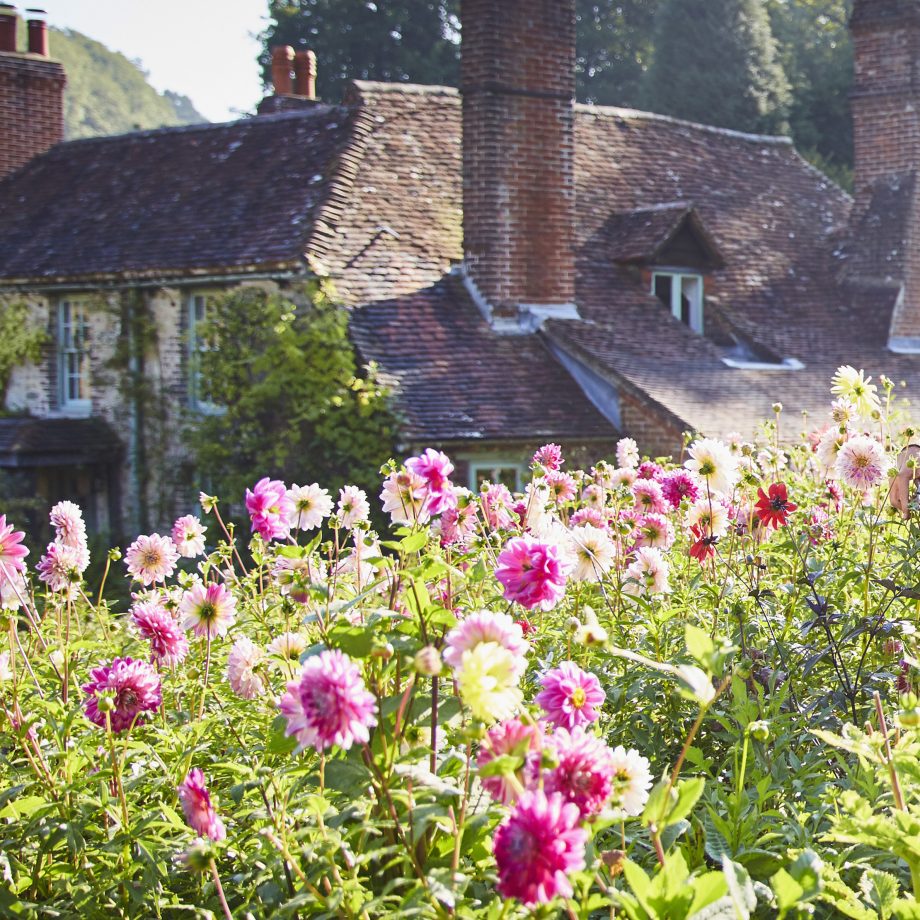The gardening writer and broadcaster Arthur Parkinson picks some of his favourite dahlias — and revels in the fact that they can be the stars at Chelsea later this year.
I’m excited that the Chelsea Flower Show is being moved to September. It will be all the more glamorous, not least because this new date means the dahlia can truly catwalk out in full, autumnal razzmatazz clout.
I’ve grown dahlias now for almost a decade and, despite a lot of huge-headed dahlia bravado that goes on, there are two classes of dahlias that I’d choose against all the others — the single and anemone varieties. They flower, but they don’t only give the garden colour, they truly give it life.

Verrone’s Obsidian or Star Dahlia
The single dahlias literally glow with golden nectar on a summer’s day. Their saffron pollen beckons, in a flying orchestra, our precious and glorious pollinators.
My eyes might be dazzled by a show of decorative dahlias, but these blooms are, in a way, soulless — man-dominated flowers, with endless tutu petals replacing their natural stamens and anthers. These are not a flower of earth, really, as they offer nothing for a bee or butterfly to feed from, so a sad silence will be the result of a dahlia bed consisting of only these cutting varieties.

The National Botanic Garden of Wales, Llanarthney, Wales
In total contrast, a bed of single dahlias can play a similar role to a wildflower meadow, brimming with nectar and pollen when pollinators need such exotic flowers the most. Single dahlias, especially, are prolific in their opening of buds. Of many dahlia varieties, they are often the first to start flowering in early June and they go on willingly into the dewy dawns of autumn providing insect refreshment.
It’s not only about their flowers, however, as many single dahlias have beautiful leaves and stems of varnished black and deep burgundy. They remind me of childhood seaside holidays in Tenby, rock-pooling among the over-cooked pasta-like fronds of rubber kelp, the flowers open above these dark foundations like crazed starfish and bizarre sea anemones.
Funnily enough, seaweed feed is a dahlia’s best friend. Both flowers and foliage will thrive on being fed this, weekly, in a diluted form from the watering can. Comfrey leaves, after being submerged for a fortnight to stew, will also fuel the flowers of dahlias brilliantly well — although beware of the foul stench this brew will create.

Dahlia ‘Blue Bayou’
I plant my dahlia tubers in late April, usually in plastic crates, lined with old pierced compost bags filled with fresh compost. If this compost is moist, then the dahlias shouldn’t be watered until they sprout — too much wet causes the tubers to rot.
A crate will hold eight dahlia tubers, nestled in and lightly covered. Once they have sprouted well, they can be put outside during the day, but should always be brought back in at night in case of frost.

Close up of Dahlia Bishop of Auckland flowering in an English garden
By the end of May, each grown plant is gently lifted from the crate like a slice of cake. Slugs and snails I keep at bay by letting the hens range freely during the winter months and by applying wildlife-friendly nematodes once the soil warms, generous mulches of oyster shell grit around young plants will help protect them, too.
Over the winter, I harvest young sapling birch twigs, which are very pliable, and stick them in around each plant to provide a wind-protecting cage. Without this kind of cage, dahlias are at risk from being ruined by any summer storms.
Arthur Parkinson’s favourite dahlias:
- ‘Bishop of Llandaff’ — postbox red with almost-black serrated foliage; one of the oldest varieties.
- ‘Bishop of Auckland’ — lavish claret petals surround a honey-yellow centre; very airy and elegant in habit.
- ‘Waltzing Mathilda’ — compact, so ideal for large pots, with pink-blushed, tangerine-peach petals.
- ‘Totally Tangerine’ — with jazzy orange starfish-like flowers, this is one of the earliest dahlias to come into bloom.
- ‘Blue Bayou’ — tall and airy, although lilac rather than blue; looks magical in the summer sun against a flutter of butterflies.
- ‘Soulman’ — a rich mulberry sea-urchin type; one of the first dahlias that I grew and forever a favourite.
- ‘Verrone’s Obsidian’ — a Catherine wheel-like exotic starburst with plush velvet petals.
Arthur Parkinson’s new book The Flower Yard, published by Kyle Books, is out now

Arthur Parkinson: ‘It’s a crime that we have forsaken our wildflower meadows for petrol lawnmowers and Flymos’

Arthur Parkinson: The ‘intensely creative’ gardener with ‘spectacular flamboyance’ rising to the top of the gardening world
Arthur Parkinson is the fresh-faced social media sensation hailed as the rising star of the gardening world. Caroline Donald went

Alan Titchmarsh: How I grow dahlias — and why they’re my second-most infallible plants
Gardener, writer and broadcaster Alan Titchmarsh has always loved dahlias — even in the days before they gained their current huge

Dahlias, the ‘miracles of complexity’ that we’ve learned to love and cherish
Charles Quest-Ritson talks about dahlias, once so unloved, and how they enjoying a surge of popularity.

Alan Titchmarsh: How the dahlia shrugged off its ‘too common to plant’ tag — and thank goodness it did
Alan Titchmarsh has always loved Dahlias — and he's all too glad that his fellow gardeners have seen sense in recent

From the Sweet Lady to the Crème de Cognac: Three expert opinions on the top dahlias to buy and plant now
The chase is on: if you want to grow the best dahlias in your borders this year, you need to




